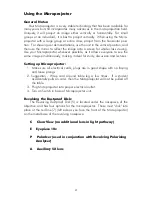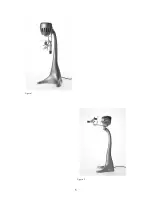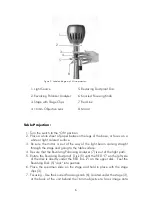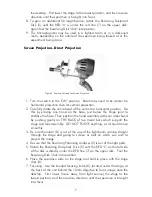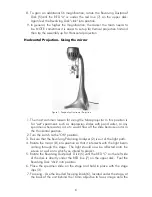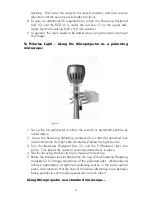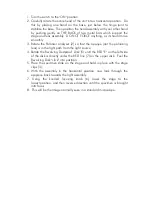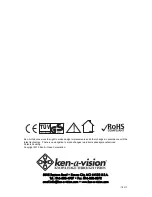
7
the desktop. First lower the stage to the lowest position, and then reverse
direction until the specimen is brought into focus.
8. To gain an additional 5X magnification, rotate the Revolving Dustproof
Disk (5) until the RED "A" is under the red line (7) on the upper disk.
Again feel the Revolving Disk "click" into position.
9. The Microprojector may be used in a lighted room or in a darkened
room, depending on the nature of the specimen being looked at or the
experiment being done.
Screen Projection- Direct Projection
Figure 2. Position of Head for Screen Projection
1. Turn the switch to the "ON" position. Room may need to be darker for
horizontal projection then for vertical projection.
2. Carefully rotate the entire head of the unit into a horizontal position. Do
this by placing one hand on the base, just below the hinge joint to
stabilize the base. Then position the head assembly with your other hand
by pushing gently on THE BACK of two metal bars which support the
stage and lens assembly. DO NOT FORCE anything, as it should move
smoothly.
3. Be sure the mirror (8) is out of the way of the light beam coming straight
through the stage and going to screen or wall on which you wish to
project the image.
4. Be sure that the Revolving Polarizing Analyzer (2) is out of the light path.
5. Rotate the Revolving Dustproof Disk (5) until the RED "C" on the left side
of the disk is directly under the RED line (7) on the upper disk. Feel the
Revolving Disk "click" into position.
6. Place the specimen slide on the stage and hold in place with the stage
clips (3).
7. Focusing - Use the knurled focusing knob (6), located under the stage, at
the back of the unit behind the 16mm objective to focus image onto the
desktop. First lower (move away from light source) the stage to the
lowest position, and then reverse direction until the specimen is brought
into focus.
Summary of Contents for Microprojector TRIG
Page 1: ...Microprojector Instruction Manual X 1000 1 TRIG ...
Page 2: ...2 ...
Page 5: ...5 Figure 1 Figure 2 ...
Page 11: ...11 ...




